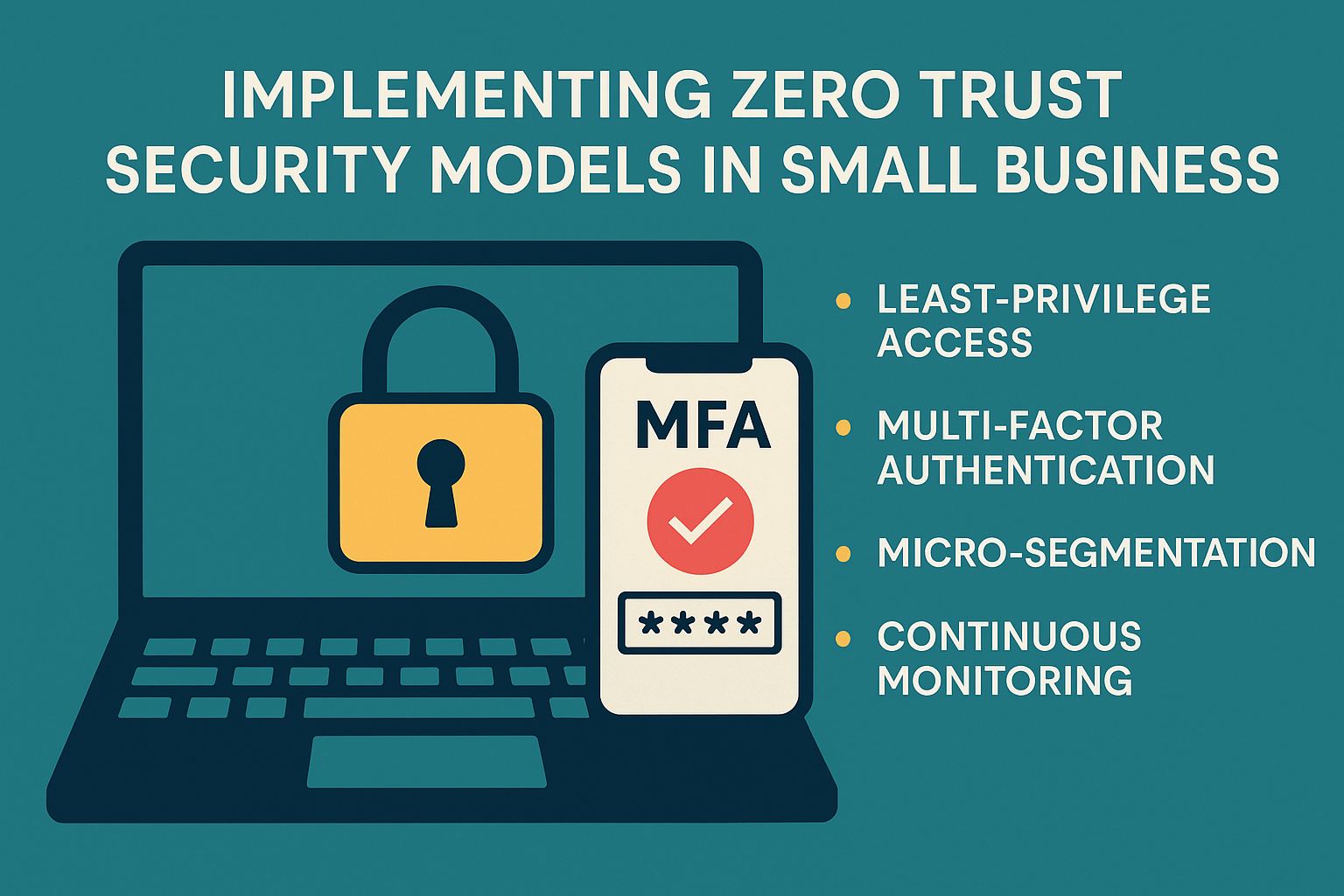
Implementing Zero Trust Security Models in Small Businesses
Zero Trust is a modern cybersecurity model designed to address today’s advanced threats by assuming that no user or device — inside or outside your network — should ever be trusted by default. Instead, everything must be verified.
This model shifts the focus from perimeter-based security to identity, device, and context-aware controls that adapt dynamically to threats. It’s a practical and essential approach for small businesses, especially those working in high-risk industries like healthcare or finance.
What Is Zero Trust Security?
At its core, Zero Trust means “never trust, always verify.” Every access request must be authenticated, authorized, and continuously monitored. This applies whether the request is coming from inside the office or a remote laptop.
Zero Trust does not rely on a hardened perimeter. Instead, it enforces controls at every point — user identity, endpoint health, network segmentation, and real-time analytics.
Why It Matters for Small Businesses
Small businesses often assume they’re too small to be targeted. In reality, they’re easier targets due to limited resources and weaker security practices.
Adopting a Zero Trust model helps you:
Reduce the impact of breaches and insider threats
Prevent lateral movement within your network
Secure remote work and bring-your-own-device (BYOD) setups
Comply with Australian privacy and data regulations
Build client trust through strong cybersecurity standards
Key Principles of Zero Trust
Least-Privilege Access
Only give users access to the systems and data they need to do their jobs — nothing more.Multi-Factor Authentication (MFA)
Verify users using more than just a password — such as a mobile app or fingerprint.Micro-Segmentation
Split your network into secure zones so a breach in one area doesn’t affect everything else.Continuous Monitoring and Analytics
Monitor user behaviour, login attempts, and access patterns to detect anomalies quickly.Device and Endpoint Verification
Only allow secure, compliant devices to access your systems. Block jailbroken phones, outdated laptops, and unknown endpoints.
How to Implement Zero Trust in Your Business
1. Audit Your Current Environment
Start by identifying users, devices, and systems. Understand who has access to what — and why.
2. Enable Multi-Factor Authentication
Apply MFA on all critical systems, especially email, remote access, and cloud services like Microsoft 365.
3. Limit Access with Role-Based Controls
Assign access based on job roles. Review access levels regularly and remove unused accounts promptly.
4. Set Up Endpoint Protection
Use endpoint security tools to monitor device health and prevent compromised devices from connecting.
5. Segment Your Network
Separate sensitive data (e.g., financial, health records) from general access areas to reduce risk.
6. Train Your Team Regularly
Human error is a major risk factor. Offer ongoing cybersecurity training to all employees — from admin staff to managers.
Real-World Example: Healthcare Clinics
At Podium IT, we work with many medical clinics across Melbourne. Implementing a Zero Trust model has helped these clients:
Lock down EMR access to authorised users only
Prevent patient data leaks due to compromised staff devices
Comply with healthcare regulations and avoid fines
Confidently allow third-party integrations like HotDoc or HealthEngine with tighter access controls
Start Your Zero Trust Journey with Podium IT
Zero Trust isn’t just for large enterprises. Small businesses can — and should — start adopting it now.
At Podium IT, we help Melbourne-based businesses put practical, affordable Zero Trust principles in place without disrupting daily operations.
Need help?
Book a free 15-minute consultation with our team to find out where to begin.
👉 www.podiumit.com.au/contact

Ashley Tietze
Managing Director | Podium IT
"Implementing Zero Trust Security Models in Small Businesses"
CONTACT US
We’re all about providing simplified and superior technology solutions that exceed our client’s expectations and add value to their business. We’d love the opportunity to meet with you and discuss how we may help you with your IT Support requirements. Please call us on the number listed or fill in the contact sheet and an enthusiastic IT Support team member will be in touch very soon.
